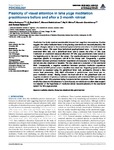Plasticity of visual attention in Isha yoga meditation practitioners before and after a 3-month retreat.
| dc.contributor.author | Braboszcz, C | en |
| dc.contributor.author | Cahn, BR | en |
| dc.contributor.author | Balakrishnan, B | en |
| dc.contributor.author | Maturi, RK | en |
| dc.contributor.author | Grandchamp, R | en |
| dc.contributor.author | Delorme, A | en |
| dc.date.accessioned | 2018-08-13T15:14:42Z | |
| dc.date.available | 2018-08-13T15:14:42Z | |
| dc.date.issued | 2013 | en |
| dc.identifier.issn | 1664-1078 | en |
| dc.identifier.uri | http://hdl.handle.net/10026.1/12119 | |
| dc.description.abstract |
Meditation has lately received considerable interest from cognitive neuroscience. Studies suggest that daily meditation leads to long lasting attentional and neuronal plasticity. We present changes related to the attentional systems before and after a 3 month intensive meditation retreat. We used three behavioral psychophysical tests - a Stroop task, an attentional blink task, and a global-local letter task-to assess the effect of Isha yoga meditation on attentional resource allocation. 82 Isha yoga practitioners were tested at the beginning and at the end of the retreat. Our results showed an increase in correct responses specific to incongruent stimuli in the Stroop task. Congruently, a positive correlation between previous meditation experience and accuracy to incongruent Stroop stimuli was also observed at baseline. We also observed a reduction of the attentional blink. Unexpectedly, a negative correlation between previous meditation experience and attentional blink performance at baseline was observed. Regarding spatial attention orientation as assessed using the global-local letter task, participants showed a bias toward local processing. Only slight differences in performance were found pre- vs. post- meditation retreat. Biasing toward the local stimuli in the global-local task and negative correlation of previous meditation experience with attentional blink performance is consistent with Isha practices being focused-attention practices. Given the relatively small effect sizes and the absence of a control group, our results do not allow clear support nor rejection of the hypothesis of meditation-driven neuronal plasticity in the attentional system for Isha yoga practice. | en |
| dc.format.extent | 914 - ? | en |
| dc.language | eng | en |
| dc.language.iso | eng | en |
| dc.subject | Stroop task | en |
| dc.subject | attention | en |
| dc.subject | attentional blink | en |
| dc.subject | global-local task | en |
| dc.subject | meditation | en |
| dc.title | Plasticity of visual attention in Isha yoga meditation practitioners before and after a 3-month retreat. | en |
| dc.type | Journal Article | |
| plymouth.author-url | https://www.ncbi.nlm.nih.gov/pubmed/24376429 | en |
| plymouth.volume | 4 | en |
| plymouth.publication-status | Published online | en |
| plymouth.journal | Front Psychol | en |
| dc.identifier.doi | 10.3389/fpsyg.2013.00914 | en |
| plymouth.organisational-group | /Plymouth | |
| dc.publisher.place | Switzerland | en |
| dcterms.dateAccepted | 2013-11-17 | en |
| dc.rights.embargoperiod | Not known | en |
| rioxxterms.versionofrecord | 10.3389/fpsyg.2013.00914 | en |
| rioxxterms.licenseref.uri | http://www.rioxx.net/licenses/all-rights-reserved | en |
| rioxxterms.licenseref.startdate | 2013 | en |
| rioxxterms.type | Journal Article/Review | en |


